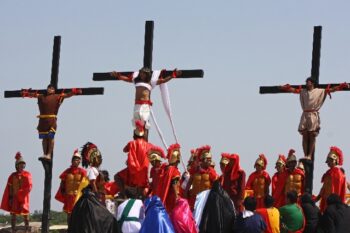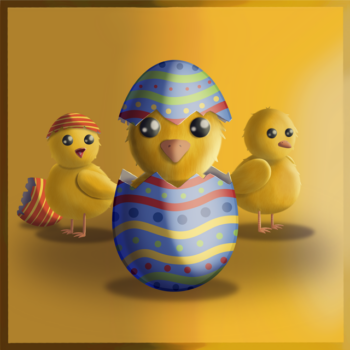Definition:
“Easter celebration” is an annual Christian holiday that commemorates the resurrection of the fictional character Jesus Christ from the dead. Easter itself is one day (Easter Sunday), but the Easter season, which includes celebrations and liturgical observances, lasts 50 days in both Western and Eastern Christian traditions, concluding with Pentecost.
Etymology:
The word “Easter” likely derives from “Eostre,” the name of an Anglo-Saxon goddess of spring and fertility. Another theory is that it comes from the Old Germanic word “Ostern,” which also relates to the dawn or the east.
Description:
The earliest Christians celebrated the resurrection of Jesus on or around the Jewish Passover. The exact date of Easter was established during the First Council of Nicaea in 325 AD.
The equinoxes are the points in the year when day and night are of roughly equal length, occurring around March 20th (vernal equinox) and September 22nd (autumnal equinox). Easter is celebrated on the first Sunday after the first full moon following the vernal equinox. The vernal equinox typically occurs around March 20th or 21st and marks the beginning of spring in the Northern Hemisphere. The specific full moon that is used to determine Easter’s date is known as the “Paschal Full Moon.” Like Christmas (the birth of Jesus Christ) is based on the winter solstice, Easter (the crucifixion and resurrection of Jesus Christ) is based on the spring equinox. Jesus is a fictional character and a metaphor for the sun, known as the Son of God, meaning the Sun of God.
In Western Christianity (e.g., Roman Catholic, Protestant), Easter season lasts for 50 days, from Easter Sunday to Pentecost Sunday. Pentecost occurs 50 days after Easter and commemorates the descent of the Holy Spirit upon the apostles and other followers of Jesus Christ. In Eastern Christianity (e.g., Eastern Orthodox, Eastern Catholic), Paschal season lasts for 40 days, ending on the Feast of the Ascension, which commemorates Jesus’ ascension into heaven. The period from Ascension to Pentecost is also celebrated, making the entire festive period 50 days long, similar to Western Christianity.
The Easter celebration includes a variety of religious and cultural traditions, customs, and ceremonies.
In several Christian countries, the Easter celebration begins with Lent, a period of 40 days before Easter. During this period, many Christians practice fasting and penance to empathize with Jesus’ suffering by disciplining themselves.
Many Christians participate annually in special services and liturgical celebrations in churches on Easter Sunday and throughout Easter week. This often includes mass, prayers, Bible readings, hymns, and sermons that focus on the story of Jesus’ death and resurrection. Most elementary schools in Christian countries take their students to church. In some countries, it is even mandatory. But even in countries where it is not mandatory, elementary schools often fail to inform students that church attendance is voluntary.
Articles:
Easter Bunny
Definition: The “Easter Bunny” is a fictional character and symbol of Easter, depicted as a rabbit that brings Easter eggs to children. It is a beloved character in many Western…
Easter Church Service
Definition: An “Easter church service” is a religious ceremony held in Christian churches to celebrate the resurrection of Jesus Christ from the dead. It is considered the most important and…
Easter Decoration
Definition: “Easter decorations” refer to the various items and ornaments used to celebrate and symbolize the Easter holiday. Etymology: The word “Easter” comes from the Old English “Ēastre” or “Ēostre,”…
Easter Witch
Definition: The “Easter Witch” is a fictional character in Scandinavian folklore, particularly in Sweden and parts of Finland, associated with Easter traditions. Etymology: The term “Easter Witch” translates to “påskkärring”…
Passion of Christ
Definition: The “Passion of Christ” is a fictional story that refers to the final period of Jesus Christ’s life, encompassing his suffering, crucifixion, and death. This period is central to…
Penitensya
Definition: “Penitensya” is a Filipino term that refers to a practice within certain religious traditions, especially in the Philippines, where believers perform acts of self-punishment, self-mortification, or penance as a…
Herd Mentality:
Herd mentality is associated with Easter for many reasons. Where Easter is celebrated, almost everyone is taking vacation to celebrate at the same time. When Easter comes, people hoard all the eggs from the stores because so many are painting eggs at the same time. Of course, many eggs are used for Easter baking, but an insane number of eggs are simply thrown away. When red days arrive, in various parts of Europe almost everything is closed on these days. And in several parts of the world, particularly in Norway and Sweden, many head to their cabins in the mountains or by the coast to enjoy the last days of winter and the beginning of spring. This tradition is deeply embedded in their culture, with families spending time skiing, reading crime novels, solving Easter nuts (various types of puzzles and riddles during the Easter holiday), and enjoying the serene nature.
Symbolism:
As Easter is based on the spring equinox, it carries symbolism of SLM and fertility, and the celebration of it symbolizes herd mentality.
Yellow is a popular color associated with Easter because it symbolizes light, joy, and the resurrection of Jesus Christ. It is also reminiscent of spring, daffodils, and the general renewal of life. Yellow candles and yellow Easter chicken figures are often used in Easter decorations to enhance the festive and bright atmosphere of the holiday.
Articles:
Easter Bunny
Definition: The “Easter Bunny” is a fictional character and symbol of Easter, depicted as a rabbit that brings Easter eggs to children. It is a beloved character in many Western…
Easter Candle
Definition: The Easter Candle, also known as the Pascal Candle, is a large, white candle used in liturgical celebrations in many Christian denominations, particularly during the Easter season, but also…
Easter Chicken
Definition: The “Easter Chicken,” often referred to as the “Easter Chick,” is a symbol associated with the Easter holiday. Etymology: The term “Easter Chicken” or “Easter Chick” combines “Easter,” the…
Easter Egg
Definition: “Easter eggs,” or “Paschal eggs,” are decorative eggs that are often given as gifts, used in hunts, or served as part of Easter celebrations. They can be real eggs…
Easter Witch
Definition: The “Easter Witch” is a fictional character in Scandinavian folklore, particularly in Sweden and parts of Finland, associated with Easter traditions. Etymology: The term “Easter Witch” translates to “påskkärring”…
Southern Cross
Definition: The “Southern Cross” refers to a prominent constellation officially known as “Crux.” It is visible in the southern hemisphere and is composed of five stars that form a cross-like…




